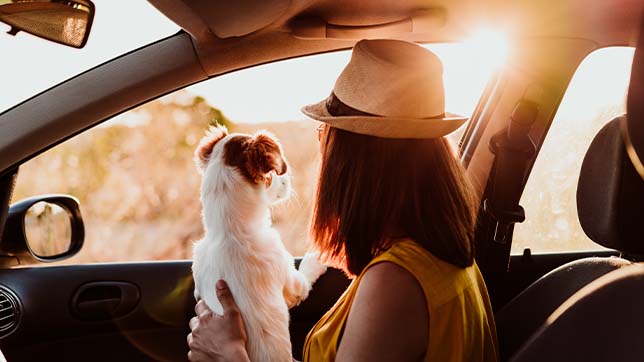1st February 2022
Roadtrips: the dog owner’s guide
If you’re planning a staycation this year, you are probably planning on driving to your destination. If your pooch is joining you on your travels, there are some things you need to do to ensure their long car journey is as pleasant as possible.
We’ve teamed up with Dog First Aid Training to bring you some tips to help ensure your dog stays safe during your road trip.

Before you go
Before heading out on the road, there are a few things you’ll need to do to make sure you are prepared for the journey ahead and to help make it as pain-free as possible for you and your pooch.
- Don’t feed before you go – Try not to let your dog eat anything right before you set off as this could cause them to be sick. Give your dog plenty of time to digest their food or feed them once you arrive at your destination.
- Let the air flow through the car – Before you set off, try opening the doors and letting cool air flow through the car by adjusting the fans to face the back seat. This can help ensure that the back seat or boot isn’t uncomfortably warm when your dog gets in.
- Plan any stops ahead of leaving – Planning ahead will allow you to find the best dog-friendly services or stops along the way.
- Make sure you have the right restraint – Use a good quality harness, or a crate or guard, to keep your dog safe while travelling. You will need to buy one of these before you travel with your dog as per rule 57 of the Highway Code.
- Pack everything you might need – Don’t just pack with your destination in mind, make sure you’re prepared for the journey ahead by packing:
- Fresh water
- Dog lead
- Poo bags
- Food and water bowls
- Toys or home comforts
- Telephone number of a vet
- First aid kit including:
- Bandages
- Cotton wool
- Wound dressing
- Wound wash
- Self-adhesive tape
- Tweezers
- Dressings
- Vinyl gloves
- Antiseptic wipes
On the way
- Make regular stops – This will allow your dog time to stretch their legs and go to the toilet. Keep them on their lead to keep them safe from passing traffic or running off in unfamiliar surroundings.
- Never leave them in a car – It doesn’t take long for a vehicle to warm up causing your dog to overheat, which can be fatal.
- Keep them away from open windows – Letting your dog put its head outside the window while you’re driving could result in an accident and cause infection in their eyes from the grit, dust and bugs that could be blown into their face.
- Keep the car cool – Have your air conditioning on and make sure that cool air reaches your dog, wherever they might be seated. If this isn’t possible, open the windows to let the fresh air flow through the vehicle.
After you arrive
There is still lots to do once you’ve reached your destination, but don’t worry we’ve got you covered.
- Let your dog out as soon as possible – Once you’ve arrived, it’s important to get your dog out of the car as soon as you’re able to, especially if you weren’t able to take any breaks.
- Take it easy – Don’t rush your dog as they get used to their new surroundings, so that they don’t become stressed or agitated.
- Consider whether to put them on the lead – unfamiliar surroundings may contain dangers that your dog is unaware of, so it may be advisable to put them on the lead until you know they can be safely let off.
- Take care when it’s warm – If it’s a hot day, make sure you don’t let your dog walk on hot pavements or else they could burn the pads of their paws and will need veterinary care.
- Look for the nearest vet – Just in case something was to happen, find the telephone number for the local vet and save it as a contact in your phone or write it down and keep it in your purse or wallet. As an Animal Friends customer, you also have free access to vet experts at Joii 24 hours a day.
This information was provided by Dog First Aid Training. Dog First Aid Training provide CPD accredited, vet-approved emergency canine care training to dog owners and people who work with dogs. To find a class near you please go to www.dog-first-aid.com or call 0800 999 6632.
Looking for more dog advice?
Find the information you need as we support you through every step of your journey with your canine companion.
Need dog insurance?
Dog insurance can help cover the cost of veterinary treatment if your dog gets injured or falls ill.
We know pets
Our pets are part of the family. To achieve our vision of a better future for pets everywhere, we work with our partners, vets, and other veterinary professionals who are pioneering the latest advancements in animal care. Our campaigns, articles, and events are crafted to support, educate, and celebrate pet owners, while our policies are designed to provide peace of mind at an affordable price.
Yet our policies don’t just protect against the unexpected – they have purpose, too.
Since we were founded over 25 years ago, we've provided industry-leading policies that protect the nation’s pets, while also making a difference to animal welfare and our planet. Thanks to you, our policyholders, we've donated over £9 million to more than 830 animal welfare charities and conservancies, helping to support vulnerable pets and wildlife around the world.
We’re proud to be wildly different. Are you?
